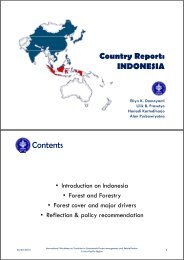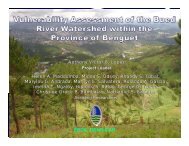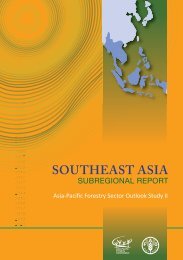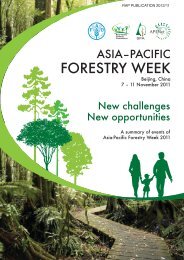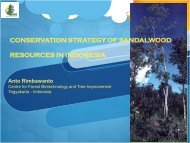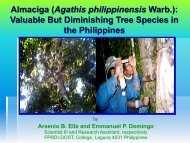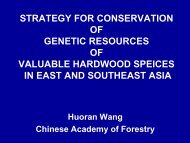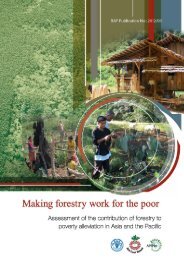Community guidelines for accessing forestry voluntary carbon ... - FAO
Community guidelines for accessing forestry voluntary carbon ... - FAO
Community guidelines for accessing forestry voluntary carbon ... - FAO
You also want an ePaper? Increase the reach of your titles
YUMPU automatically turns print PDFs into web optimized ePapers that Google loves.
Chapter 6: Identifying, managing and quantifying risks<br />
validity – they expire after five years. After they expire, the holder of<br />
the tCERs (usually the registry of an industrialized country with emission<br />
reduction commitments under the Kyoto Protocol) has to either buy<br />
new credits or reduce its emissions directly. Industrialized countries<br />
with emission reduction commitments do not face this issue with non-<br />
A/R CERs and this is one of the reasons why the demand <strong>for</strong> credits from<br />
A/R CDM projects is depressed, and why the growth of <strong>for</strong>estry projects<br />
under the CDM has been slow.<br />
The permanence risk is addressed differently under the VCM. Investors<br />
in the VCM do not want two different types of credit. They want<br />
permanent credits which are fully ‘fungible’ (inter-exchangeable) with<br />
credits from other sectors. VCS there<strong>for</strong>e developed its “AFOLU nonpermanence<br />
risk tool”. It is the most powerful and widely accepted<br />
approach to ensuring fungibility of credits from <strong>for</strong>estry VCM projects<br />
and can be downloaded from: http://www.v-c-s.org/sites/v-c-s.org/files/<br />
AFOLU%20Non-Permanence%20Risk%20Tool%2C%20v3.1.pdf<br />
This tool outlines procedures <strong>for</strong> analyzing the risk of non-permanence<br />
(reversal) and determines what proportion of the <strong>carbon</strong> benefits are<br />
exposed to this risk. This proportion of <strong>carbon</strong> credits are put in a<br />
‘buffer’ that provides insurance against the risk of reversal. However, if<br />
these risks do not occur as the project progresses, some credits will be<br />
released from the buffer and can then enter the market. Some risks are<br />
permanent and there<strong>for</strong>e a certain proportion of credits will never be<br />
released <strong>for</strong> sale. The minimum buffer is always 10 percent, regardless<br />
of the risk assessment of the project.<br />
Projects can also undertake specific activities to mitigate risk – <strong>for</strong><br />
instance by putting a good fire detection system in place – which will<br />
reduce the proportion of credits that need to be placed in the buffer.<br />
The tool helps project proponents, implementing partners and VVBs to<br />
assess the risks and determine the appropriate changes to the buffer.<br />
The tool sets a very high standard. This is necessary considering the<br />
level of investment in the VCM and the importance of the VCM to retain<br />
credibility as a valid approach to climate change mitigation. However, it<br />
141




